
Drexel Hill (484) 521-0233
West Chester (610) 436-5883

Drexel Hill (484) 521-0233
West Chester (610) 436-5883
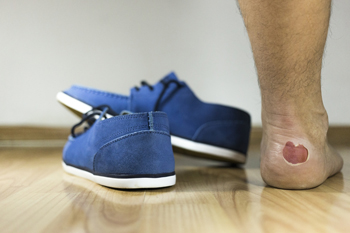
Blisters are quite a common form of foot affliction that can affect a wide variety of people. Blisters are filled with fluid and often develop on the feet in response to friction placed on the affected area. Other times, blisters can form on the feet in response to burns. Some individuals with this condition have the urge to pop these blisters. However, it is important to note that popping certain kinds of blisters is not recommended and may be dangerous. For example, it is generally not advisable to pop a burn blister. These blisters can be highly susceptible to infection. Sometimes, these blisters might pop on their own. In this case, you might consider keeping the blister covered. Maintaining moisture in the wound, perhaps with ointment, might also be beneficial. Contact a podiatrist today for more information.
Blisters are prone to making everyday activities extremely uncomfortable. If your feet are hurting, contact the podiatrists of Dr. Siegerman & Associates. Our doctors can provide the care you need to keep you pain-free and on your feet.
Foot Blisters
Foot blisters develop as a result of constantly wearing tight or ill-fitting footwear. This happens due to the constant rubbing from the shoe, which can often lead to pain.
What Are Foot Blisters?
A foot blister is a small fluid-filled pocket that forms on the upper-most layer of the skin. Blisters are filled with clear fluid and can lead to blood drainage or pus if the area becomes infected.
How Do Blisters Form?
Blisters on the feet are often the result of constant friction of skin and material, usually by shoe rubbing. Walking in sandals, boots, or shoes that don’t fit properly for long periods of time can result in a blister. Having consistent foot moisture and humidity can easily lead to blister formation.
Prevention & Treatment
It is important to properly care for the affected area in order to prevent infection and ease the pain. Do not lance the blister and use a Band-Aid to provide pain relief. Also, be sure to keep your feet dry and wear proper fitting shoes. If you see blood or pus in a blister, seek assistance from a podiatrist.
If you have any questions, please feel free to contact one of our offices located in Drexel Hill and West Chester, PA . We offer the newest diagnostic and treatment technologies for all your foot care needs.
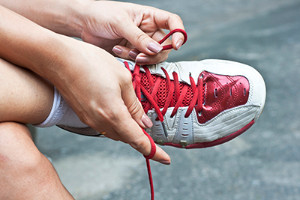
There are basic things to look for when purchasing running shoes. It is important to decide what type of running will be practiced, and this generally consists of mileage that is high, medium, or low. This is followed by choosing a shoe that will fit your foot, such as having a wider toe box, or a certain type of heel. Additionally, the type of surface that is run on will determine what type of shoe to buy. Running on pavements will require road shoes to be worn, and these are adequate in providing shock absorption. Trail shoes are designed to be worn while running through soft muddy trails, and wearing hybrid shoes is recommended for running on various surfaces. It is beneficial to bring the socks that are worn to try on with the shoes, in addition to bringing insoles, if applicable. If you would like more information about what type of shoes to buy for specific types of running, please consult with a podiatrist who can help you to make choices that are right for you.
You should always make sure your running shoes fit properly in order to avoid injury. For more information, contact the podiatrists from Dr. Siegerman & Associates. Our doctors can provide the care you need to keep you pain-free and on your feet.
Choosing the Right Running Shoe for Your Foot Type
Improper shoe sizing can cause a myriad of problems for your feet. Shoes that don’t fit you properly can lead to muscular imbalances in your body, which can result in foot, knee, and hip injuries.
Tips for Finding the Right Running Shoe
If you have any questions please feel free to contact our one of our offices located in Drexel Hill and West Chester, PA . We offer the newest diagnostic and treatment technologies for all your foot and ankle needs.
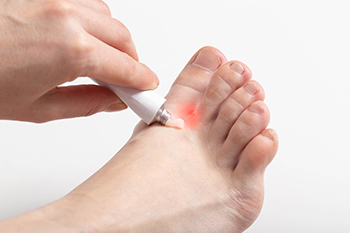
Athlete's foot is certainly an affliction of the foot that one ought to avoid. It develops in an individual when a fungal infection takes hold of their feet often between the toes, and creates a rash. There are several ways in which an individual can take steps to avoid athlete’s foot. One often overlooked way is to be diligent about maintaining one’s carpeting. If you have bought a new home from someone else, you might find that the carpeting can be quite dirty, often still harboring fungal spores deep in the carpets. If the previous owners had walked around barefoot on those carpets, it is possible that they spread a fungus into the carpet. If this applies to you, you might consider deep cleaning the carpet to remove these damaging fungi. Doing this might ultimately protect you and your family from developing athlete’s foot. Schedule an appointment with a podiatrist to learn more.
Athlete’s foot is an inconvenient condition that can be easily reduced with the proper treatment. If you have any concerns about your feet and ankles, contact the podiatrists from Dr. Siegerman & Associates. Our doctors will treat your foot and ankle needs.
Athlete’s Foot: The Sole Story
Athlete's foot, also known as tinea pedis, can be an extremely contagious foot infection. It is commonly contracted in public changing areas and bathrooms, dormitory style living quarters, around locker rooms and public swimming pools, or anywhere your feet often come into contact with other people.
Solutions to Combat Athlete’s Foot
Athlete’s foot can cause many irritating symptoms such as dry and flaking skin, itching, and redness. Some more severe symptoms can include bleeding and cracked skin, intense itching and burning, and even pain when walking. In the worst cases, Athlete’s foot can cause blistering as well. Speak to your podiatrist for a better understanding of the different causes of Athlete’s foot, as well as help in determining which treatment options are best for you.
If you have any questions please feel free to contact one of our offices located in Drexel Hill and West Chester, PA . We offer the newest diagnostic and treatment technologies for all your foot and ankle needs.
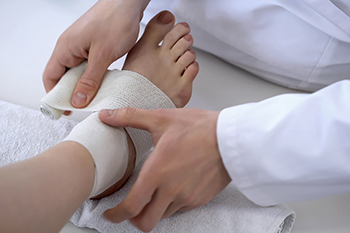
An ankle sprain occurs by twisting the ankle beyond its normal range of motion. A common type of sprain is the eversion sprain, resulting from rolling the ankle inward. Doing this can damage the ligaments in the ankle and cause severe pain or discomfort. The ankle can be sprained in several ways, including running on uneven surfaces and changing directions suddenly while engaging in sporting activities. Additionally, wearing shoes that do not fit correctly or provide minimal support may be another reason a sprained ankle can happen. An X-ray is often taken to provide a proper diagnosis. This is successful in ruling out a fracture, and the right course of treatment can begin. Many people use crutches to keep their weight off the affected foot. If you have sprained your ankle, please consult a podiatrist who can determine the type of sprain and help you with the correct treatment.
Although ankle sprains are common, they aren’t always minor injuries. If you need your ankle injury looked at, contact the podiatrists from Dr. Siegerman & Associates. Our doctors can provide the care you need to keep you pain-free and on your feet.
How Does an Ankle Sprain Occur?
Ankle sprains are the result of a tear in the ligaments within the ankle. These injuries may happen when you make a rapid shifting movement while your foot is planted. A less common way to sprain your ankle is when your ankle rolls inward while your foot turns outward.
What Are the Symptoms?
Preventing a Sprain
Treatment of a Sprain
In many cases, the RICE method (Rest, Ice, Compression, and Elevate) is used to treat ankle sprains. However, you should see a podiatrist to see which treatment option would work best with your injury. In severe cases, surgery may be required.
It is important to ask your doctor about rehab options after you receive treatment for your injury. Stretching, strength training, and balance exercises may help the ankle heal while also preventing further injury.
If you have any questions, please feel free to contact one of our offices located in Drexel Hill and West Chester, PA . We offer the newest diagnostic and treatment technologies for all your foot care needs.
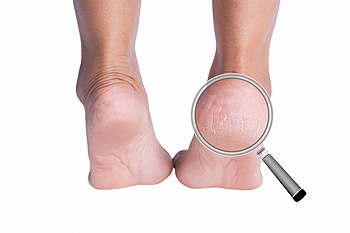
It is a well-known fact that individuals suffering from diabetes can often experience a number of different foot conditions. One such foot condition that diabetics might experience is cracked heels. The condition of cracked heels is defined by fissures on one’s heels that result from a lack of moisture and hydration. Although many individuals with cracked heels might not experience any severe symptoms, cracked heels can be uncomfortable in some cases. Diabetics can be particularly susceptible to this condition because they often have nerve damage that can lead to an inability to produce sweat in the sweat glands. Ultimately, when the feet cannot produce sweat, they become excessively dry, which can cause cracked heels. If you are a diabetic, consider contacting a podiatrist today who can help you manage your condition and prevent cracked heels.
Cracked heels are unsightly and can cause further damage to your shoes and feet. If you have any concerns, contact the podiatrists from Dr. Siegerman & Associates. Our doctors can provide the care you need to keep you pain-free and on your feet.
Cracked Heels
Cracked heels appear unappealing and can make it harder for you walk around in sandals. Aside from looking unpleasant, cracked heels can also tear stockings, socks, and wear out your shoes. There are several methods to help restore a cracked heel and prevent further damage.
How Do You Get Them?
Dry skin is the number one culprit in creating cracked heels. Many athletes, walkers, joggers, and even swimmers suffer from cracked heels. Age and skin oil production play a role to getting cracked heels as well.
Promote Healing
Over the counter medicines can help, especially for those that need instant relief or who suffer from chronic dry feet.
Wear Socks – Wearing socks with medicated creams helps lock in moisture.
Moisturizers – Applying both day and night will help alleviate dryness which causes cracking.
Pumice Stones – These exfoliate and remove dead skin, which allows for smoother moisturizer application and better absorption into the skin.
Change in Diet
Eating healthy with a well-balanced diet will give the skin a fresh and radiant look. Your body responds to the kinds of food you ingest. Omega-3 fatty acids and zinc supplements can also revitalize skin tissue.
Most importantly, seek professional help if unsure how to proceed in treating cracked heels. A podiatrist will help you with any questions or information needed.
If you have any questions, please feel free to contact one of our offices located in Drexel Hill and West Chester, PA . We offer the newest diagnostic and treatment technologies for all your foot care needs.
Request a free copy of
Laser Away Foot Pain!
today.
